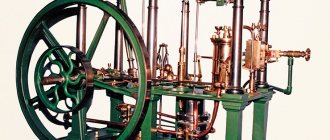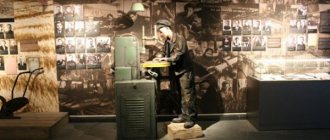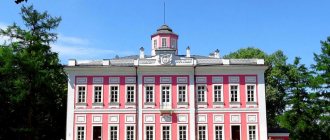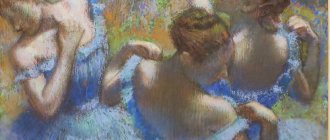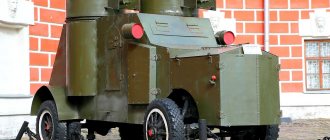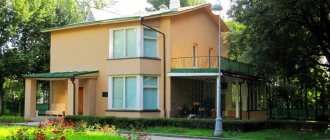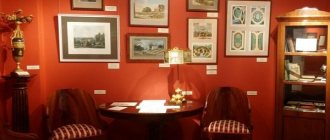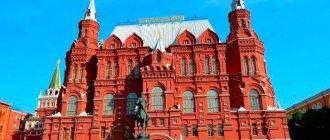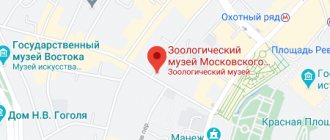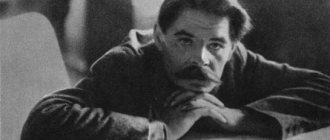Russia does it itself
“Russia Does Itself” is an interactive exhibition of the Polytechnic Museum, opened in pavilion No. 26 “Transport” at VDNKh during the reconstruction of the historical Polytechnic building.
The exhibition presents 7 scientific fields, the topics of which are of particular relevance for modern science: “Radio+”, “Plasma Energy”, “Core Energy”, “Illusions”, “Analogues of Nature”, “New Anthropogenesis” and “Life Beyond the Earth” " Using exhibits from the collection of the Polytechnic Museum as an example, each section reveals to visitors the history of the most important scientific discoveries and inventions made by domestic researchers. Having discovered each of the sections, visitors will be able to clearly and using real examples evaluate how much contribution Russian scientists have made to world science. The sections are not isolated from each other and, while maintaining chronological order, demonstrate the connection between different scientific fields and technologies. Everything is just like in life - after all, many important discoveries are made at the intersection of different scientific disciplines.
All exhibits are equipped with information signs; touch screens are installed next to the key ones, allowing you to see more detailed information.
The main feature of the exhibition is a truly high degree of interactivity, which takes RDS to a level higher than most other exhibitions of similar topics. The exhibits are not just collecting dust behind glass - many of them can be seen in action simply by activating them with a public button. The exhibition includes a large number of multimedia installations, and each section of the exhibition is equipped with its own virtual guide. Virtual guides are worthy of special praise: by communicating with the scientists, doctor, gopnik or astronaut depicted on the life-size screen using gestures, visitors can familiarize themselves with the exhibition in great detail, even to the point that the electronic character will tell them which way they should turn their head.
Sections and exhibits of the exhibition
The exhibition “Russia Does Itself” consists of 7 sections, each of which has its own exposition and multimedia installations included in it.
“Radio+” section introduces visitors to the use of electromagnetic waves in various areas of human life. Visitors are invited not only to get acquainted with the history of the research, but also to touch the magnetic field “by touch” using a special device that converts the strength of the magnetic field into tactile sensations. In addition, here you can see Popov’s lightning detector, the Zarnitsa radar station, a small collection of televisions and radios, models of antennas of various types and much more.
“Plasma Energy” will help visitors understand what plasma is, where it can be found in nature and how to use it for human benefit. The exhibits in the section will demonstrate plasma in various states, Petrov's electric arc and artificial lightning. Another interesting exhibit was a plasma loudspeaker that reproduces sound thanks to the oscillations of the discharge plasma: with just two buttons, visitors will be able to control the plasma, making the sound louder or quieter.
In the “Nuclear Energy” , visitors to the exhibition will be able to get acquainted with the history of the “taming” of nuclear energy and the use of related technologies for peaceful and military purposes. The central place in the exhibition is given to the RDS-1 atomic bomb, the model of which has become one of the most stunning interactive exhibits in Russia, literally and figuratively: standing in front of the bomb, visitors can feel what the RDS-1 testers felt at the Semipalatinsk test site. The area under your feet will begin to vibrate, the rumble of the aircraft will begin to increase, and then suddenly the roar of an explosion will be heard. Also available for viewing are dynamic models of the F-1 and Romashka nuclear reactors, a model of the Topaz space nuclear installation and other exhibits.
“Illusions” allows visitors to look behind the scenes of holography - a technology that allows you to view three-dimensional images without stereoscopes or special glasses. In a small dark room you can see a collection of stereoscopes and a set of holograms, as well as a unique exhibit - an installation for recording reflection holograms using the method of Yuri Denisyuk.
The section “Analogues of Nature” reveals how our understanding of natural phenomena and processes is translated into very specific technical inventions: from the simplest little things to robots and complex neurocomputers. Visitors can see Lukyanov’s hydraulic integrator, an electrical integrator resistance panel, a collection of counting objects, a device for digitizing water, neurocomputer boards, as well as the installations “Fractals in Nature,” “Spherulite,” and “Biosphere.” Also of interest are the Soviet robot guide “Sepulka” (1962, designer M. Alexandrov, artist M. Gorokhov), the mechanical doll “Suok”, a six-legged walking machine and Chebyshev’s plantigrade machine, which in the past was a success at the World Exhibition in Paris in 1878 .
In the “New Anthropogenesis” , visitors can familiarize themselves with theories of post-biological evolution and learn how modern technologies can help expand the functions of the human body. Interactive panels will talk about artificial living organisms, digitization and transfer of personality, and other promising technologies that, until recently, were only in the wildest dreams of science fiction writers. Also, a significant part of the exhibits is devoted to the topic of restoring lost functions of the human body: visitors can see a robotic prosthetic arm, learn about the successes of transplantologists and get acquainted with the achievements of regenerative medicine, which makes it possible to grow organs from the patient’s own stem cells.
“Life beyond Earth” is a section dedicated to space exploration and the prospects for the colonization of other planets. Visitors to the exhibition will be treated to an excursion into the research of Konstantin Tsiolkovsky and other Soviet and Russian scientists and inventors who played a role in space exploration. Among the exhibits you can see spacesuits for spacewalks, space nutrition and a sewage and sanitary device from the Mir station - a toilet device that regenerates non-potable water from the urine of astronauts. A special place is given to models of space stations of the ships: “Vostok”, “Venera-9” and USSR-09. A number of models depict the stage-by-stage colonization of Mars: from the landing and construction of the first habitable station to - literally - the planting of gardens and forests.
Bottom line
The exhibition “Russia Does Itself” (RDS) is an excellent and truly interactive exhibition that will be of interest to visitors of any age.
Having looked at the exhibition, visitors will hardly find out what Russia can do on its own, since its exhibits mainly illustrate the history of Soviet research and even the abbreviation of the exhibition name - “RDS” - indicates the Soviet atomic bomb, but high-quality execution compensates for this shortcoming .
A large number of not only spectacular, but also educational installations, themed games, the opportunity to see exhibits in action and communicate with virtual guides, which in themselves have become one of the most interesting exhibits - advantages thanks to which we can safely say that “Russia does it itself” - one of the most interesting and technologically advanced exhibitions available in Moscow today.
You can get acquainted with the opening hours and procedures for visiting the exhibition “Russia Does Itself” on the website of the Polytechnic Museum: polymus.ru
PhotoTelegraph
While the historical building of the Polytechnic Museum is under reconstruction, on the territory of VDNKh there is a museum exhibition called “Russia Does Itself” (although the achievements of Soviet science are mostly presented). Nevertheless, the exhibition is very interesting, both in terms of the composition of the exhibition and the approach to its organization. PhotoTelegraph correspondent visited the exhibition and is in a hurry to share his impressions. (14 photos, 2 videos)
discuss photo (0)
The exhibition is organized really well! Frankly, I was expecting the usual museum approach of “exhibit + sign”, however, immediately at the entrance, visitors are greeted by this interactive screen-lecturer. The screen reacts to a person passing by and offers to listen to a lecture on the history of radio; the screen is controlled by gestures. The structure behind the screen is a musical instrument that can be played by moving your hands in an electromagnetic field.
discuss photo (0)
The hall displays samples of the first radios and the first televisions. In the photo: TV “Leningrad”.
discuss photo (0)
A visitor to the exhibition studies information at one of the stands. Information stands are also interactive, equipped with a touchscreen and, where necessary, headphones.
discuss photo (0)
Next comes a room dedicated to holography. At the entrance to the hall, the TV lecturer offers to talk about the invention of holography, and in the hall itself there are stunning three-dimensional photographs.
discuss photo (0)
And also a device for obtaining such images – Denisyuk’s holographic installation. Active replication. Filming is carried out by a museum employee at the request of visitors.
discuss photo (0)
And here are the “first computers”. The photo shows Lukyanov's hydraulic integrator. A device for solving differential equations, the operation of which is based on the flow of water. The device consists of a vascular system. Various cross-sectional areas of the vessels, the system for connecting them to each other, hydraulic resistance and other elements make it possible to take into account all the specified conditions and visually reproduce the process under study.
discuss photo (0)
Also a very interesting exhibit related to water. This device converts a stream of water into binary computer code. Each cup can deviate either to the right or to the left, thus, reaching the base of the pyramid, the water forms a certain state of the lower cups, which is recorded by sensors. The right position of the cup is zero, the left is one. Below is a video of this process.
discuss photo (0)
And here is the binary information taken from the jet.
discuss photo (0)
One of the first servers of the Yandex search engine, 1997. A search index of the Russian-language Internet was stored on two of its 9 GB hard drives.
discuss photo (0)
Another wonderful exhibit is Chebyshev’s plantigrade machine. Pafnuty Lvovich Chebyshev (1821-1894) - Russian mathematician and mechanic, inventor of hinged devices and mechanisms. One of them is a plantigrade machine, the world's first walking mechanism. The machine was a great success at the Paris Exhibition of 1878. And a video is projected onto the screen in the hall, which simply cannot leave indifferent a person who has taken a course in theoretical mechanics.
discuss photo (0)
These are exhibits from the space exploration hall. Options for building colonies on the planets of the Solar System are presented.
discuss photo (0)
Hydroponics is a method of growing plants in artificial environments, without soil. One of the parts of the closed-loop self-sustainment system for long-distance space flights.
discuss photo (0)
And this is a model of the first Soviet atomic bomb RDS-1. And this exhibit is interactive too!
discuss photo (0)
Do you see the area with the number five in the back? This is where you need to stand to feel what the first testers of this bomb felt at the Semipalatinsk test site in August 1949.
# museums, science, technology
